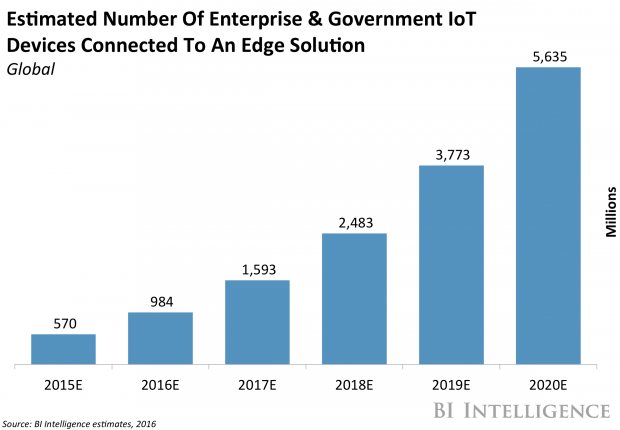Explores the top industries projected to deploy edge computing.
For businesses, the most important benefit of the IoT will be the data generated by billions of new smart sensors and devices. The Internet of Everything all of the people and things connected to the internet will generate 507.5 zettabytes (1 zettabyte = 1 trillion gigabytes) of data by 2019, according toCisco. Managing, sifting through, and analyzing so much data will be a massive challenge for organizations. But that data analysis will be essential if IoT initiatives are going to provide the insights to drive greater productivity and revenues.
Logo for Business Insider over a transparent background.
pass to BI Intelligence and gain immediate access to this report and over 100 other expertly researched reports. As an added bonus, youll also gain access to all future reports and daily newsletters to ensure you stay ahead of the curve and benefit personally and professionally.
EDGE COMPUTING IN THE IoT: Forecasts, key benefits, and top industries adopting an analytics model that improves processing and cuts costs
A report from BI Intelligence looks at the market for edge computing solutions tied to the IoT and explains the specific benefits and challenges around using edge computing for enterprise IoT data storage and processing. It also examines which industries we expect to lead in adopting edge computing and how the technology could increase productivity and efficiency in these particular sectors.
You have successfully emailed the post.
Details the key benefits of edge computing, including reduced operational costs and lower latency.
EDGE COMPUTING IN THE IoT: Forecasts, key benefits, and top industries adopting an analytics model that improves processing and cuts costs
Deploying edge computing for IoT devices can be a complicated task, but emerging standards could help simplify deployments.
Edge computing provides a means to collect and process data at local computing devices rather than in the cloud or a remote data center.
Registration on or use of this site constitutes acceptance of ourTerms of ServiceandPrivacy Policy.
Interested in getting the full report? Here are two ways to access it:
EDGE COMPUTING IN THE IoT: Forecasts, key benefits, and top industries adopting an analytics model that improves processing and cuts costs
We expect that the manufacturing, utilities, energy, and transportation industries will be the fastest to adopt the technology. These industries will be followed by smart cities, agriculture, healthcare and retail.
Highlights the three places where data can be collected, processed, and analyzed in a typical IoT deployment.
We estimate that 5.6 billion IoT devices owned by enterprises and governments will utilize edge computing for data collection and processing in 2020.
Edge computing is often better suited for collecting and processing data from IoT devices than the cloud. Edge computing can be accomplished using gateway networking devices, industrial PCs, or micro data centers.
For businesses, the most important benefit of…
Looks at the market for edge computing.
The edge computing model is uniquely well suited to IoT applications because of several key benefits, including near real-time analysis of data, lower costs related to operations and data management, reduced data sent back to the cloud (and, therefore, less constricted networks), and the assurance that other IT assets will remain operational
Purchase & download the full report from our research store.
* Copyright © 2018 Insider Inc. All rights reserved.

Right now, most of this data management and analysis is performed in the cloud or enterprise data centers. However, several IoT technology providers are promoting a different model called edge computing, or fog computing, for the IoT. In an edge computing model, sensors and connected devices transmit data to a nearby edge computing device, such as a gateway device (a networking device like a switch or router) that processes or analyzes the data, instead of sending it back to the cloud or a remote data center.
